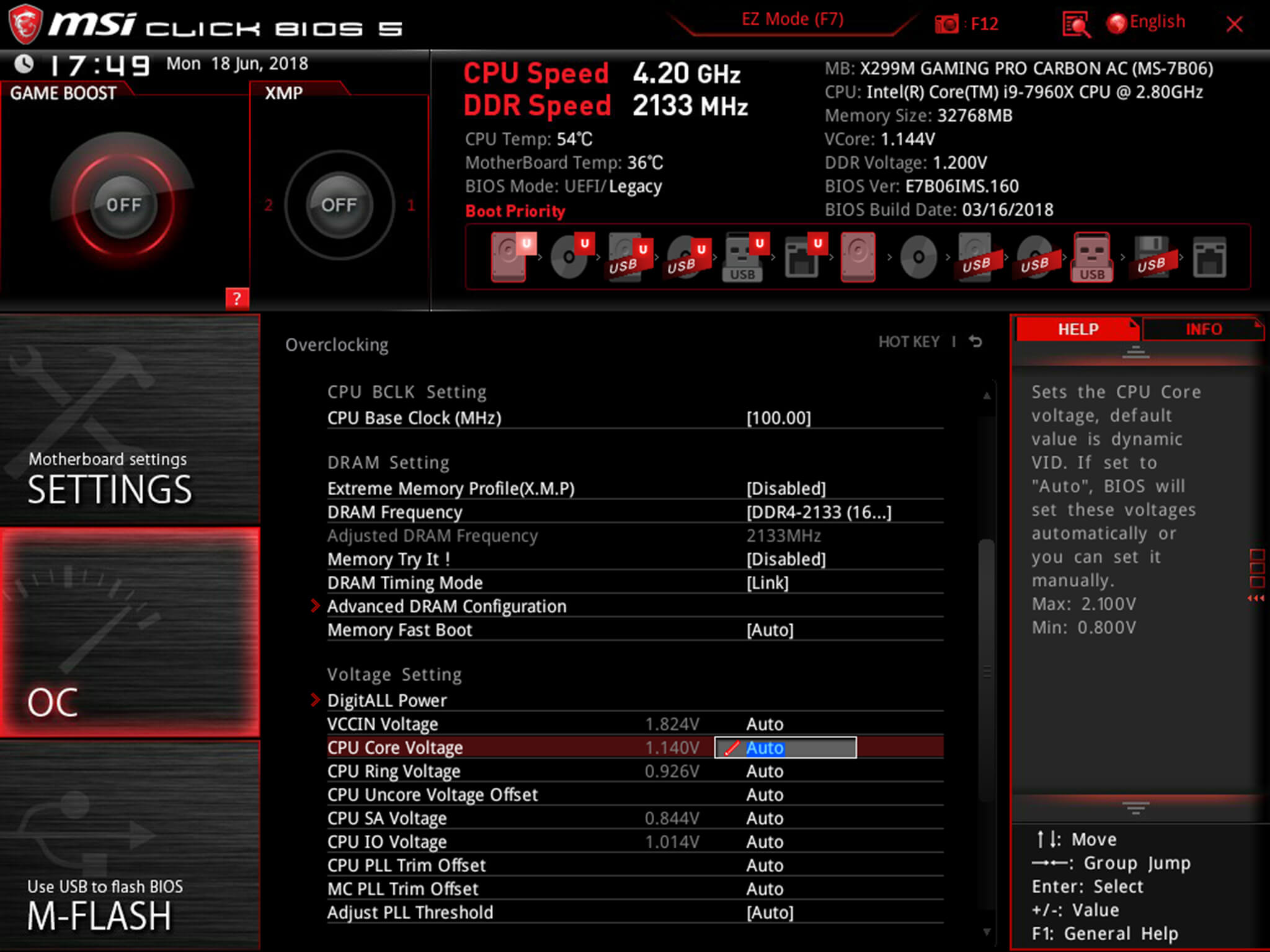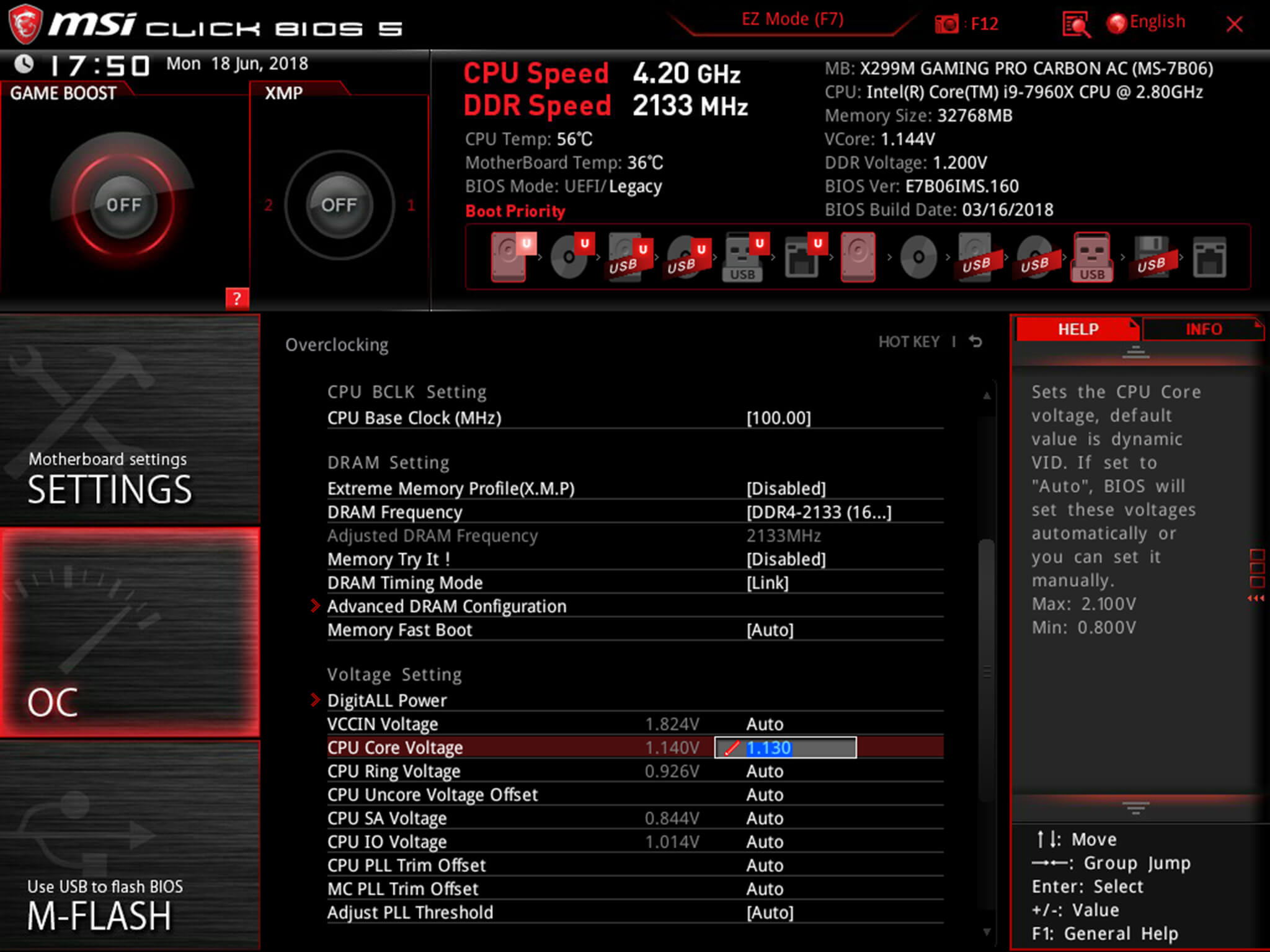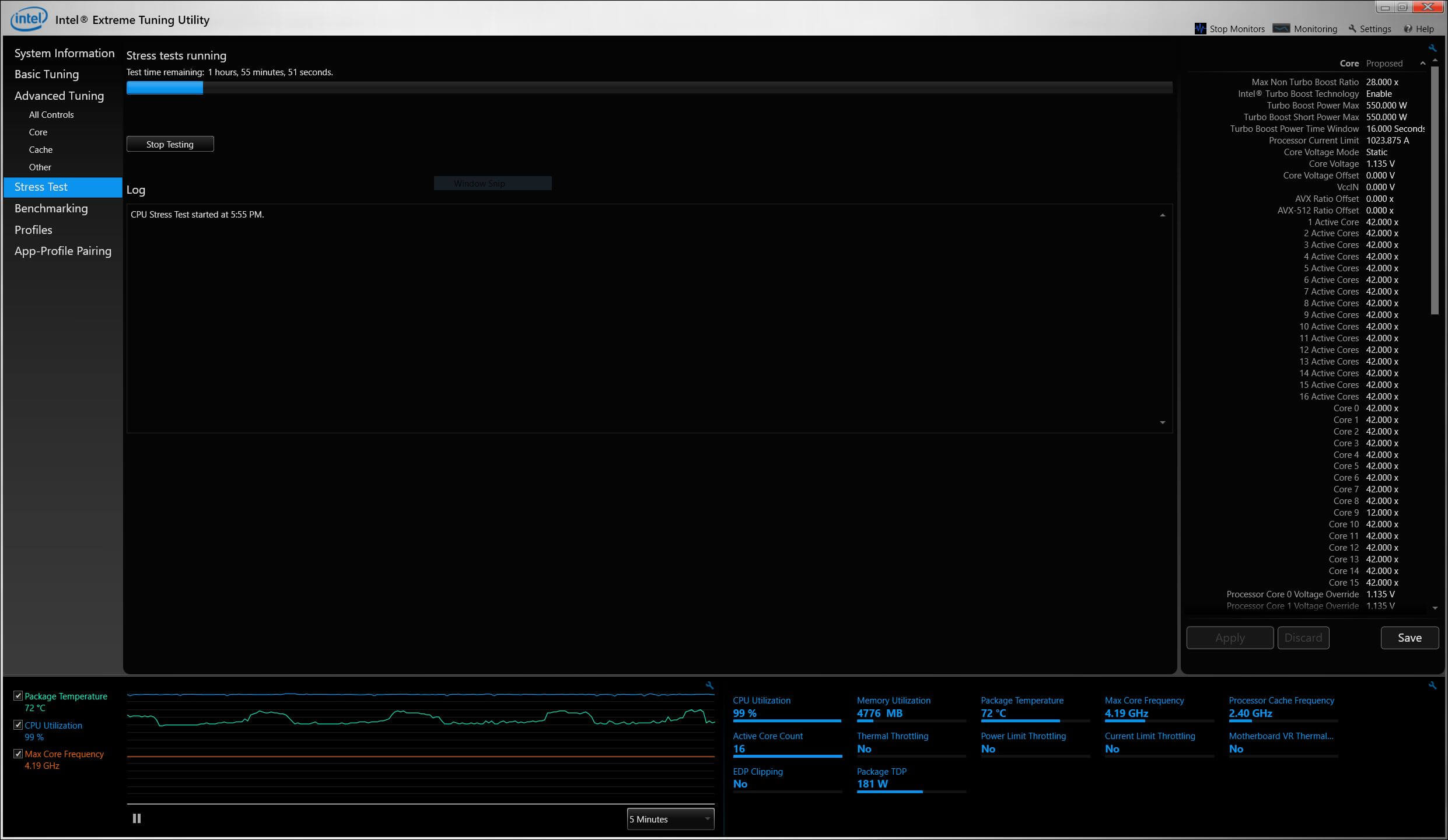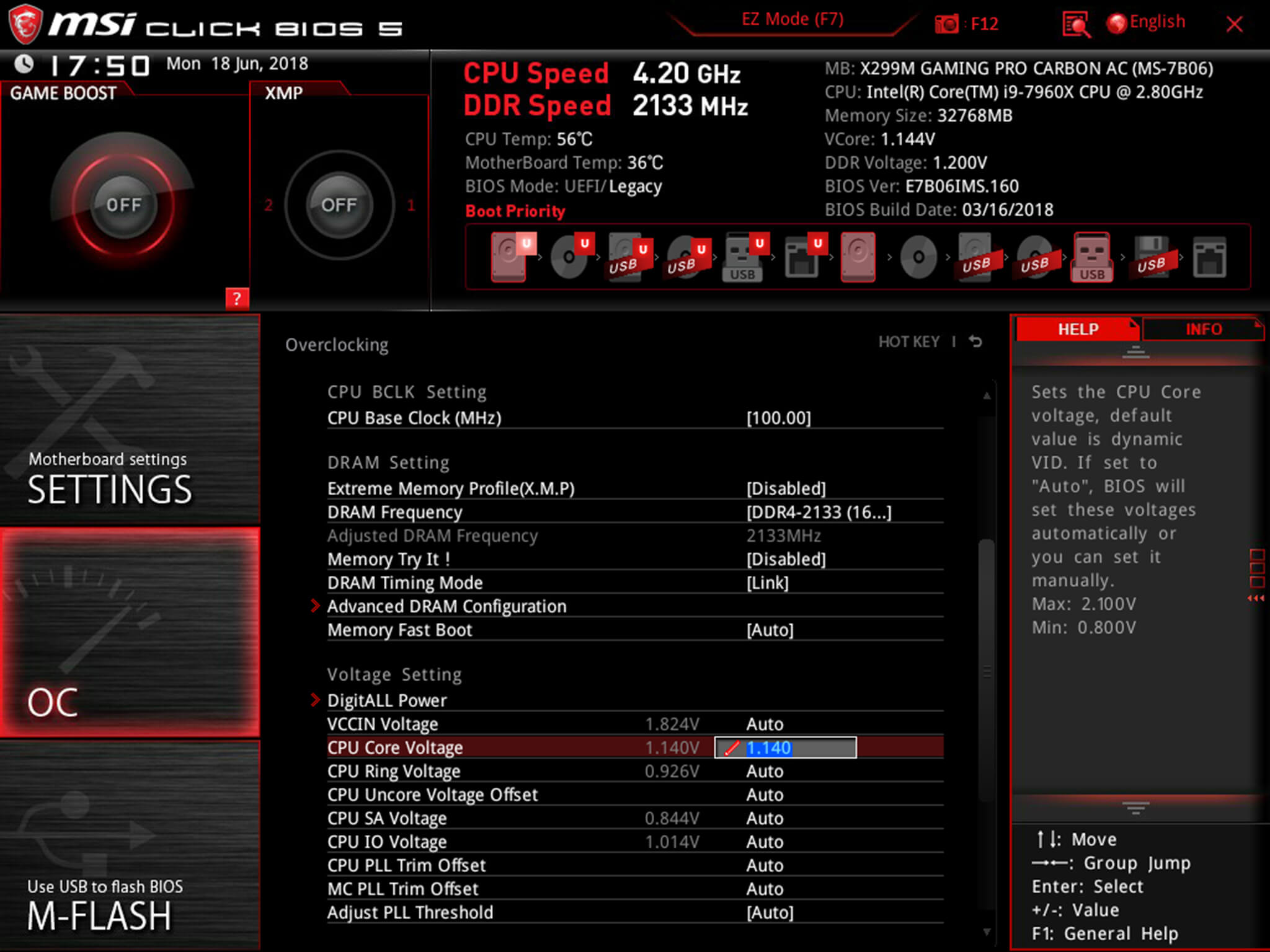The core voltage is different for each processor model, and while all CPUs of the same model have the same VID, not all samples maintain stability at the same clock speeds and Vcore due to slight variations in silicon quality. Every sample of the same CPU model is tested to maintain stability at the default speeds and the VID determined by the manufacturer.
Core voltage typically maintains a constant value while your CPU is in use; however, sometimes under heavy workloads vcore can fluctuate. This is known as Vdroop and can be corrected with load-line calibration. This applies additional voltage as load increases to maintain your CPU's stability.
When it comes to overclocking, you can only push your CPU's frequency so far before your CPU starts to experience instability. Programs might begin to crash or hang up, game performance could suffer or your computer could even fail to boot. This is because your processor isn't getting enough voltage to maintain system stability.
Increasing voltage will allow you to dial in the perfect overclock.
To adjust the voltage, you'll need to boot into your motherboard's BIOS and make adjustments there. The Vcore is expressed as a three decimal value, such as 1.235v. By default, the voltage control is set to auto; this can be overridden by typing in any value. Make sure not to exceed the recommended maximum for your processor.

Before fine-tuning the Vcore, it's important to find a good baseline value for a given speed. This varies from model to model but it can be helpful to read reviews for your CPU, specifically ones that focus on overclocking.
Most publications will list the voltage they required to keep several different speeds stable. Every CPU sample is different and you will need to fine-tune the voltage before calling it done; however, these values do provide a good starting point.

If you boot your machine and don't find any stability issues, then you know it's time to start decreasing the voltage. When overclocking, you want to find the lowest voltage required to maintain stability. More voltage equals more heat and this will allow you to keep temperatures under control.

The safest way to adjust voltage is with increments of .01 volts. Decrease voltage until your computer starts showing signs of instability under load. Use a program like Intel's Extreme Tuning Utility (XTU) or Prime95 to stress test your processor.
If the test fails or crashes, then you need to raise the voltage back up to the previous stable point. For optimal efficiency, you can increase the voltage by .005 instead and again test for stability.

Conversely, if your overclock isn't stable at your baseline voltage, you will then need to increase the voltage until your computer shows no adverse effects and then decrease in increments of .005 to fine tune.

Overclocking is not the only time it can be useful to adjust voltage. As mentioned, higher voltage levels cause your CPU to generate more heat, regardless of frequency. Some CPU samples may have a higher VID than is actually required at the default frequency. Undervolting your processor allows your to maintain stability while decreasing temperatures and extending the life of your processor.
It's a common misconception that disabling Turbo Boost is a more effective substitute for shedding heat. While this does result in decreased temperatures, it is not an alternative as the purpose of undervolting is to maintain the same level of performance while generating less heat. When making adjustments, the same principles apply here as with overclocking, decrease Vcore in increments of .01 and then fine tune with adjustments of .005.
 Best rope light deal: Save 25% on Lepro N1 AI Smart RGB LED Strip Lights
Best rope light deal: Save 25% on Lepro N1 AI Smart RGB LED Strip Lights
 Big Bird flies into your stories with Sesame Street's first Snapchat filter
Big Bird flies into your stories with Sesame Street's first Snapchat filter
 Lenovo's foldable PC will be available later this year for $2,499
Lenovo's foldable PC will be available later this year for $2,499
 Hyundai reveals flying taxis for Uber Air
Hyundai reveals flying taxis for Uber Air
 Alienware M16 Gaming Laptop deal: Save $560
Alienware M16 Gaming Laptop deal: Save $560
 Dell's flexible display concept hints at a bendy laptop future
Dell's flexible display concept hints at a bendy laptop future
 Samsung's Sero is a vertical 4K TV perfect for TikTok and Instagram
Samsung's Sero is a vertical 4K TV perfect for TikTok and Instagram
 Once again, Trump makes one of his old tweets 'fake news'
Once again, Trump makes one of his old tweets 'fake news'
 Samsung's rolling robot Ballie is like your own personal BB
Samsung's rolling robot Ballie is like your own personal BB
 Dell's flexible display concept hints at a bendy laptop future
Dell's flexible display concept hints at a bendy laptop future
 Every single wig Moira Rose has worn on 'Schitt's Creek'
Every single wig Moira Rose has worn on 'Schitt's Creek'
 Juno is a countertop appliance that chills your bottle of wine in minutes, literally
Juno is a countertop appliance that chills your bottle of wine in minutes, literally
 NYT Strands hints, answers for April 14
NYT Strands hints, answers for April 14
 Facebook announces ban on deepfakes, but it won't stop misinformation
Facebook announces ban on deepfakes, but it won't stop misinformation
 Dell's flexible display concept hints at a bendy laptop future
Dell's flexible display concept hints at a bendy laptop future
 Jodie Comer and Andrew Scott play
Jodie Comer and Andrew Scott play
 NYT Strands hints, answers for May 2
NYT Strands hints, answers for May 2
 Theresa May tells Vogue why 'gentleman' Donald Trump held her hand
Theresa May tells Vogue why 'gentleman' Donald Trump held her hand
Dear Lynda: Help! Infectious Boredom and PeeReading and Eating Paris by Jennifer Burek PierceMouths Full of Earth: An Interview with Kapka KassabovaNotes on H.D. and Her BiographersAnnouncing Our New Web Editor by The Paris ReviewLittle Red and Big Bad, Part 6The Ashbery FilesMerce Cunningham’s Legacy PlanA Friend with a HeartLife’s Dull: A Letter from Philip Larkin to Kingsley AmisStaff Picks: Arthur Schnitzler, Mary Jo Bang, and Winnie the PoohLittle Red and Big Bad, Part 3Emoji Poetry Contest, Part 2Little Red and Big Bad, Part 5Writing a Memoir of Difficult WomenThe Competing, Indignant Voices in “Rights”Type Writing: An Interview with Jim Shepard by Lesley M.M. BlumeLittle Red and Big Bad, 2The Competing, Indignant Voices in “Rights”Chekhov On: A Case of Mania Grandiosa Webb telescope zooms in on solar system object shooting jets into space Chip firm Biren plans Hong Kong IPO to raise $300 million funding, sources say · TechNode Chicago Sky vs. New York Liberty 2024 livestream: Watch WNBA for free China’s Geely reportedly set to make and sell vehicles with Renault in Brazil · TechNode Walmart Plus deal: Save $49 on a yearlong Walmart+ membership Li Auto shares surge after teasing its first all Maichi Network issues apology and removes Pokémon: Reborn after lawsuit · TechNode Apple tests DeepSeek model but shifts to Alibaba for AI features in China · TechNode Prime Day 2024: 20+ wireless earbuds deals on Bose, Apple, Sony, and more Spacecraft snaps image of ancient Mars lake bigger than any on Earth Scientists discover mysterious deep sea creature. It hunts with a hood. Toyota sets up wholly NASA spacecraft has roamed billions of miles — but hasn't reached the 'edge' Former Google DeepMind VP joins ByteDance as Seed team research lead · TechNode Early Prime Day deal: $110 off Shark cordless stick vacuum (IX141) NYT's The Mini crossword answers for July 11 Chinese automakers to stay ahead despite Tesla rolling out FSD features, expert says · TechNode Sun unleashes solar storm at Earth, U.S. may see brilliant aurora Unpacked July 2024: New Samsung Galaxy Buds 3 can deliver real Scientists witness stunning, unprecedented fish carnage in the ocean
1.9576s , 10133.4140625 kb
Copyright © 2025 Powered by 【Singapore Archives】,Wisdom Convergence Information Network